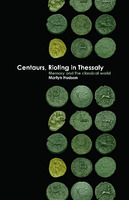Centaurs, Rioting in Thessaly: Memory and the Classical World
Author(s)
Hudson, Martyn
Collection
ScholarLedLanguage
EnglishAbstract
This book treads new paths through the labyrinths of our human thought. It meanders through the darkness to encounter the monsters at the heart of the maze: Minotaurs, Centaurs, Automata, Makers, Humans. One part of our human thought emerges from classical Ionia and Greek civilisation more generally. We obsessively return to that thought, tread again its pathways, re-enact its stories, repeat its motifs and gestures. We return time and time again to construct and re-construct the beings which were part of its cosmology and mythology – stories enacted from a classical world which is itself at once imaginary and material. The “Never Never Lands” of the ancient world contain fabulous beasts and humans and landscapes of desire and violence. We encounter the rioting Centaurs there and never again cease to conjure them up time and time again through our history. The Centaur mythologies display a fascination with animals and what binds and divides human beings from them. The Centaur hints ultimately at the idea of the genesis of civilisation itself. The Labyrinth, constructed by Daedalus, is itself a prison and a way of thinking about making, designing, and human aspiration. Designed by humans it offers mysteries that would be repeated time and time again – a motif which is replicated through human history. Daedalus himself is an archetype for creation and mastery, the designer of artefacts and machines which would be the beginning of forays into the total domination of nature. Centaurs, Labyrinths, Automata offer clues to the origins and ultimately the futures of humanity and what might come after it.
Keywords
classical literature; ancient history; monsters; mythology; centaursDOI
10.21983/P3.0192.1.00ISBN
9781947447417, 9781947447400OCN
1100490789Publisher
punctum booksPublisher website
https://punctumbooks.com/Publication date and place
Brooklyn, NY, 2018Classification
Ancient Greek religion and mythology


 Download
Download